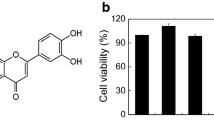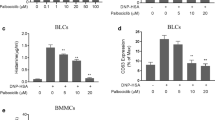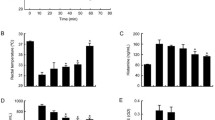Abstract
Background
Rosmarinic acid (RA), a polyphenol from edible-medical Lamiaceae herbs, is known to possess a variety of pharmacological activity, like anti-inflammatory, hepatoprotective and immunoregulation activities.
Methods and results
Hereon, we investigated the anti-allergic activity of RA on immunoglobulin E (IgE)-mediated anaphylaxis responses in rat basophilic leukemia (RBL)-2H3 mast cell. RA hindered the morphological changes of IgE-induced degranulated RBL-2H3 cells. The release of two key biomarkers (β-hexosaminidase (β-HEX) and histamine) of IgE-induced degranulated mast cells was also remarkably down-regulated by RA intervention in a dose dependent manner. Moreover, RA inhibited IgE-induced ROS overproduction and flux of intracellular Ca2+ in IgE-mediated degranulated mast cells. The q-PCR analysis showed that the expressions of genes (COX 2, PGD 2, LTC 4, HDC, Nrf2, HO-1 and NQO1) involved in MAPK and oxidative stress signaling pathways were significantly regulated by RA intervention. Moreover, the degranulation inhibitory effect of rosmarinic acid was investigated on the anti-DNP IgE/DNP-HSA induced passive cutaneous anaphylaxis (PCA) mice model in vivo. It showed that RA significantly inhibited the PCA reaction and allergic edema of ears in anti-DNP IgE/DNP-HSA stimulated mice.
Conclusion
These findings suggest that RA has the potential to be used as a therapeutic candidate for allergic diseases by inhibiting mast cell degranulation. This indicates a possible role for RA in managing allergic reactions and related conditions.





Similar content being viewed by others
Data availability
The data that support the findings of this study are available on request from the corresponding author upon reasonable request.
References
Bessa C, Francisco T, Dias R, Mateus N, Freitas Vd, Pérez-Gregorio R (2021) Use of polyphenols as modulators of food allergies. From chemistry to biological implications. Front Sustain Food Syst 5:623611
Braegelmann C, Niebel D, Ferring-Schmitt S, Fetter T, Landsberg J, Hölzel M, Effern M, Glodde N, Steinbuch S, Bieber T et al (2022) Epigallocatechin-3-gallate exhibits anti-inflammatory effects in a human interface dermatitis model-implications for therapy. J Eur Acad Dermatol Venereol 36:144–153
Civelek M, Bilotta S, Lorentz A (2022) Resveratrol attenuates mast cell mediated allergic reactions: potentia l for use as a nutraceutical in allergic diseases? Mol Nutr Food Res 66:e2200170
Desheva Y, Mamontov A, Petkova N, Karev V, Nazarov P (2020) Mast cell degranulation and histamine release during A/H5N1 influenza infection in influenza-sensitized mice. Life Sci 258:118230
Fei X, Je I-G, Shin T-Y, Kim S-H, Seo S-Y (2017) Synthesis of gallic acid analogs as histamine and pro-inflammatory cyt okine inhibitors for treatment of mast cell-mediated allergic inflammation. Molecules 22:898
Frieri M (2018) Mast cell activation syndrome. Clin Rev Allergy Immunol 54:353–365
Fu S, Ni S, Wang D, Fu M, Hong T (2019) Berberine suppresses mast cell-mediated allergic responses via regulating FcɛRI-mediated and MAPK signaling. Int Immunopharmacol 71:1–6
Guan H, Luo W, Bao B, Cao Y, Cheng F, Yu S, Fan Q, Zhang L, Wu Q, Shan M (2022) A comprehensive review of rosmarinic acid: from phytochemistry to pharmacology and its new insight. Molecules 27:3292
Hiemori-Kondo M, Morikawa E, Fujikura M, Nagayasu A, Maekawa Y (2021) Inhibitory effects of cyanidin-3-O-glucoside in black soybean hull extract on RBL-2H3 cells degranulation and passive cutaneous anaphylaxis reaction in mice. Int Immunopharmacol 94:107394
Hitl M, Kladar N, Gavarić N, Božin B (2020) Rosmarinic acid–human pharmacokinetics and health benefits. Planta Med 87:273–282
Hitl M, Kladar N, Gavarić N, Božin B (2021) Rosmarinic acid-human pharmacokinetics and health benefits. Planta Med 87:273–282
Kawauchi H, Yanai K, Wang D-Y, Itahashi K, Okubo K (2019) Antihistamines for allergic rhinitis treatment from the viewpoint of nonsedative properties. Int J Mol Sci 20:213
Kim Y-Y, Je I-G, Kim MJ, Kang B-C, Choi Y-A, Baek M-C, Lee B, Choi JK, Park HR, Shin T-Y et al (2017) 2-Hydroxy-3-methoxybenzoic acid attenuates mast cell-mediated allergic reaction in mice via modulation of the FcεRI signaling pathway. Acta Pharmacol Sin 38:90–99
Kim DE, Min K-j, Kim M-J, Kim S-H, Kwon TK (2019) Hispidulin inhibits mast cell-mediated allergic inflammation through down-regulation of histamine release and inflammatory cytokines. Molecules 24:2131
Kubo M (2018) Mast cells and basophils in allergic inflammation. Curr Opin Immunol 54:74–79
Li L, Liu R, Peng C, Chen X, Li J (2022) Pharmacogenomics for the efficacy and side effects of antihistamines. Exp Dermatol 31:993–1004
Luo C, Zou L, Sun H, Peng J, Gao C, Bao L, Ji R, Jin Y, Sun S (2020) A review of the anti-inflammatory effects of rosmarinic acid on inflammatory diseases. Front Pharmacol 11:153
Ma J, Tong P, Chen Y, Wang Y, Ren H, Gao Z, Yue T, Long F (2022) The inhibition of pectin oligosaccharides on degranulation of RBL-2H3 cells from apple pectin with high hydrostatic pressure assisted enzyme treatment. Food Chem 371:131097
Maintz L, Novak N (2007) Histamine and histamine intolerance. Am J Clin Nutr 85:1185–1196
Nishikawa H, Wakano K, Kitani S (2007) Inhibition of NADPH oxidase subunits translocation by tea catechin EGCG in mast cell. Biochem Biophys Res Commun 362:504–509
Niu L, Wei J, Li X, Jin Y, Shi X (2021) Inhibitory activity of narirutin on RBL-2H3 cells degranulation. Immunopharmacol Immunotoxicol 43:68–76
Noor S, Mohammad T, Rub MA, Raza A, Azum N, Yadav DK, Hassan MI, Asiri AM (2022) Biomedical features and therapeutic potential of rosmarinic acid. Arch Pharm Res 45:205–228
Ohtsu H (2012) Pathophysiologic role of histamine: evidence clarified by histidine decarboxylase gene knockout mice. Int Arch Allergy Immunol 158(Suppl 1):2–6
Passante E, Frankish N (2009) The RBL-2H3 cell line: its provenance and suitability as a model for the mast cell. Inflamm Res 58:737–745
Simonsen E, Komenda P, Lerner B, Askin N, Bohm C, Shaw J, Tangri N, Rigatto C (2017) Treatment of uremic pruritus: a systematic review. Am J Kidney Dis 70:638–655
Stone KD, Prussin C, Metcalfe DD (2010) IgE, mast cells, basophils, and eosinophils. J Allergy Clin Immunol 125:S73-80
Suzuki Y, Yoshimaru T, Inoue T, Niide O, Ra C (2005) Role of oxidants in mast cell activation. Chem Immunol Allergy 87:32–42
Swindle EJ, Metcalfe DD (2007) The role of reactive oxygen species and nitric oxide in mast cell-depe ndent inflammatory processes. Immunol Rev 217:186–205
Wang K, Pramod SN, Pavase TR, Ahmed I, Lin H, Liu L, Tian S, Lin H, Li Z (2020) An overview on marine anti-allergic active substances for alleviating food-induced allergy. Crit Rev Food Sci Nutr 60:2549–2563
Yamanishi Y, Karasuyama H (2016) Basophils and mast cells in immunity and inflammation. Semin Immunopathol 38:535–537
Yang H, Qu Y, Gao Y, Sun S, Ding R, Cang W, Wu R, Wu J (2022) Role of the dietary components in food allergy: a comprehensive review. Food Chem 386:132762
Yao Y, Li R, Liu D, Long L, He N (2022) Rosmarinic acid alleviates acetaminophen-induced hepatotoxicity by targeting Nrf2 and NEK7-NLRP3 signaling pathway. Ecotoxicol Environ Saf 241:113773
Yu Y, Li Y, Qi K, Xu W, Wei Y (2022) Rosmarinic acid relieves LPS-induced sickness and depressive-like behaviors in mice by activating the BDNF/Nrf2 signaling and autophagy pathway. Behav Brain Res 433:114006
Zhang W, Cheng C, Sha Z, Chen C, Yu C, Lv N, Ji P, Wu X, Ma T, Cheng H et al (2021) Rosmarinic acid prevents refractory bacterial Pneumonia through regulating Keap1/Nrf2-mediated autophagic pathway and mitochondrial oxidative stress. Free Radic Biol Med 168:247–257
Zhao Y, Li X, Chu J, Shao Y, Sun Y, Zhang Y, Liu Z (2021) Inhibitory effect of paeoniflorin on IgE-dependent and IgE-independent mast cell degranulation in vitro and vivo. Food Funct 12:7448–7468
Funding
This research was founded by Open Research Fund Program of Key Laboratory for Deep Processing of Major Grain and Oil, Ministry of Education, China (No: NJZ2022009).
Author information
Authors and Affiliations
Contributions
QY and H-LZ: wrote the main manuscript text. BJ, JS and XW: exerted the data curation. LX: was responsible for the methodology. MF: analyzed the data. FZ: written the project administration. QY: was responsible for the funding acquisition. All authors reviewed the manuscript.
Corresponding author
Ethics declarations
Conflict of interest
The authors declare no competing interests.
Ethical approval
All the experiments were approved by the Animal Care and Use Committee of Wuhan polytechnic university.
Additional information
Publisher’s Note
Springer Nature remains neutral with regard to jurisdictional claims in published maps and institutional affiliations.
Rights and permissions
Springer Nature or its licensor (e.g. a society or other partner) holds exclusive rights to this article under a publishing agreement with the author(s) or other rightsholder(s); author self-archiving of the accepted manuscript version of this article is solely governed by the terms of such publishing agreement and applicable law.
About this article
Cite this article
Jia, B., Zeng, HL., Shang, J. et al. Inhibitory effect of rosmarinic acid on IgE-trigged mast cell degranulation in vitro and in vivo. Mol Biol Rep 51, 194 (2024). https://doi.org/10.1007/s11033-023-09164-z
Received:
Accepted:
Published:
DOI: https://doi.org/10.1007/s11033-023-09164-z




